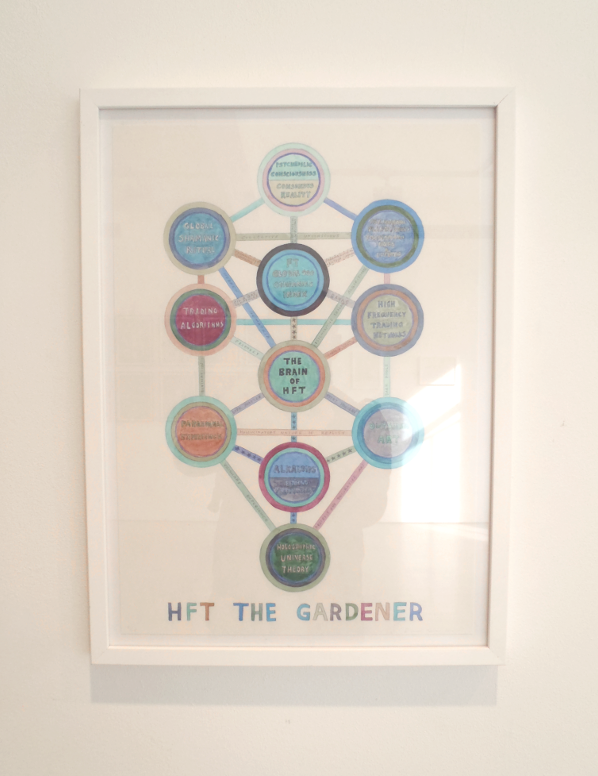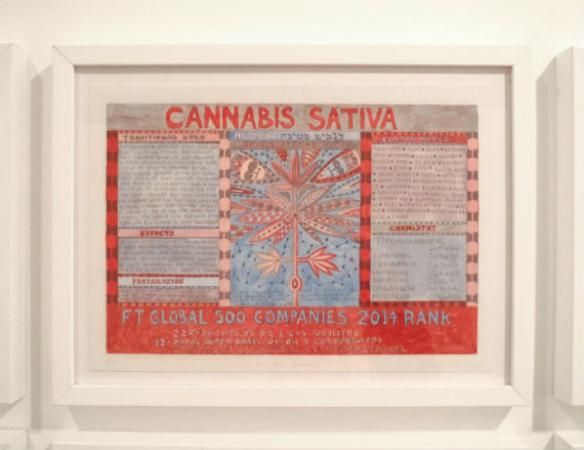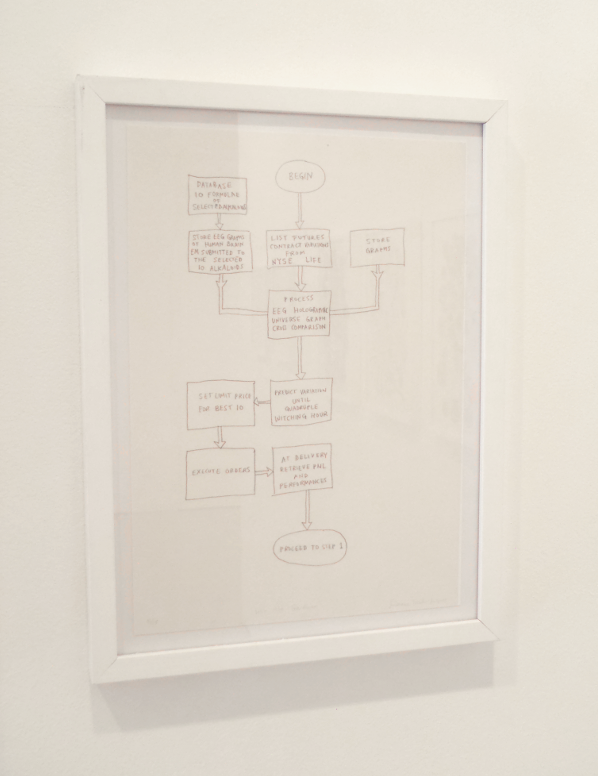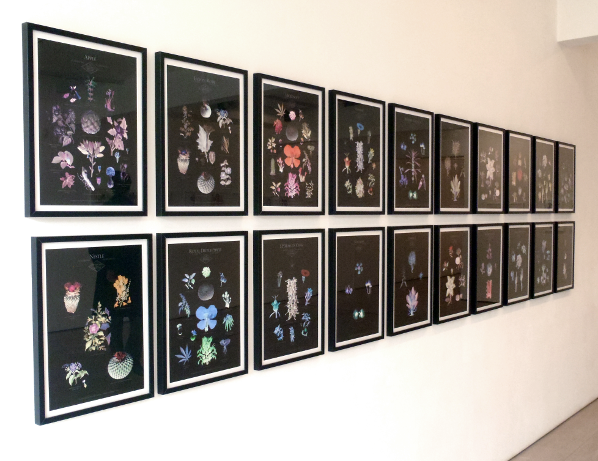



At first glance networks and the practice of drawing would seem to be worlds apart. However, the diagram, originally a hand-drawn symbolic form, has long been employed by science as a means of visualising and explaining concepts. Perhaps the most important of these concepts is that of relationships visualised as circles and lines that represent nodes and links or effectively what is related. As such networks, that is groupings of relationships, have come to be visualised through the use of the same styles and iconography employed in diagrams. For artists to reclaim the diagram as a part of their own practice and thereby adopt the practice of visualising networks developed within science sees the practice of creating diagrams in a sense come full circle. Artists have time and time again drawn diagrams and networks that explore relationships. For example: Josef Beuys famously used blackboard diagrams as part of his teaching performances concerning art and politics; Stephen Willats has since the 1960s developed drawn diagrammatic works that explore his socially formed practice; Mark Lombardi drew societies’ networks of power relations throughout the 1990s; Torgeir Husevaag has since the late 1990s drawn diagrams of a number of networks within which he participated while Emma McNally draws diagrammatic networks “bringing different spaces into relation [such as] the virtual world, the networked world and the supposedly real world” (Hayward, 2014).

The work of Suzanne Treister resides within this category of artist’s drawing, and in this instance also painting, networks. With a background in painting Treister works across video, the internet, interactive technologies, photography, drawing and watercolour painting (Treister, n.d.). Her work employs “eccentric narratives and unconventional bodies of research to reveal structures that bind power, identity and knowledge” (ibid) within contemporary contexts. As a result of this process of revealing structures, essentially the relationships within the subject matter she addresses and the resulting networks they form, her practice has since the 1990s been closely allied with art that employs or explores technology. She has been repeatedly included in exhibitions and publications that link her work with networks, cybernetics, new media and most recently Post-Internet Art (Flanagan and Booth, 2002; Pickering, 2012; Larsen, 2014; Warde-Aldam, 2014).
HFT the Gardener (2014-15), a recent solo exhibition by Treister at Annely Juda Fine Art in London, is a body of artworks consisting of drawings, paintings, photographs and digital prints supposedly created by a fictional character and a documentary video about the same character. The character, Hillel Fischer Traumberg, is an algorithmic high-frequency trader (HFT) within the London Stock Exchange. After an optically induced semi-hallucinogenic state, Traumberg experiments with psychoactive drugs in order to recreate and further the experience (Treister, 2015). Along the way Traumberg becomes fascinated with botany, experiments with the molecular formulae of drugs as trading algorithms, makes links between the numerological equivalents of plants’ botanical names and the FT Global 500 index, visually documenting all of his research and ultimately becoming an ‘outsider’ artist (ibid). In the process Traumberg transitions from an insider of one network, a trader within the stock exchange, to that of an outsider in another, the contemporary art world.


This juxtaposition of opposites is repeated throughout the exhibition. For example, the drawings and paintings of HFT the Gardener employ illustrations of networks containing nodes and links. These illustrate a number of different sets of relationships that are established by the artist. These include: that of the central character to his concepts, research and environment; the locations where drugs were taken; states of consciousness; the components of an algorithm; different companies within a sector and different aspects of the universe including life and art. Additionally a variety of diagrammatic forms are co-opted in the creation of the drawings and paintings including the Judaic Kabbalah Tree of Life, radial diagrams, flowcharts similar to those used in software design and reference is made to a number of other abstracted forms including star charts, snow crystals, fractals and paisley design. Through both form and subject matter the illustrations of networks and the diagrams gather together combinations of opposites. There is of course the use of what can be considered traditional media to illustrate new media forms, however among others there are also the opposites of painting and software, science and art, corporate and counter-culture, belief and fact, fiction and reality.
To coincide with the creation of the artwork a book of the same name has been published. In the foreword Erik Davis states that there is an “initial shock of Treister’s juxtaposition of esoterica and the financial sector” (2016). The same could be said of the numerous other juxtapositions that occur within HFT the Gardener. However, are Treister’s, or is it Traumberg’s, combinations really contrasts that shock? Treister does more than simply juxtapose opposites. The artist effectively synthesises them into a whole that is indicative of our networked era where individuals routinely select, cut, paste and combine combinations ad-hoc to suit a moment or context. HFT the Gardener is an artwork that could only be created in this era of networks and as such it cannot be considered shocking or out of context with the eclectic recombinatory society that surrounds it.

Not only are drawn diagrams and networks employed extensively throughout the exhibition in a number of ways but a network-like structure is also employed to arrange the artworks within the space of the gallery. Initially on entering the gallery space it seems as if artworks are arranged in no particular order. However it gradually becomes clear that this arrangement is purposefully obliging the visitor to enter into and move through the space as if it were a network; that is entering at any point and navigated in any order. While some series of artworks within HFT the Gardener, such as the Botanical prints, maintain an order to illustrate the ranking of companies employed in their creation, the majority of artworks are experienced out of the order they have been created and the documentary video about Traumberg, presumably from Treister’s perspective, is encountered at the midpoint of the exhibition. As such the artworks are presented as if they are interconnected nodes in a network.

As a result of the diagrams, illustrations of networks, juxtaposed combinations of subject matter and a network-like structure in arranging the artworks within the exhibition Treister successfully manages to make one last combination of opposites, that of non-linearity of experience and linearity of narrative. In doing so the visitor experiences the juxtapositions, combinations and resulting networks formed by Traumberg’s hallucinatory non-linear associations and yet manages to steadily interpret the detailed narrative carefully constructed by the artist. It is in this last combination where the strength of Treister’s exhibition lies as it not only reflects society at large but also suggests that art is and perhaps always has been, a non-linear networked experience that is only now coming into its own.
An exhibition catalogue of HFT The Gardener is available through ISSUU (https://issuu.com/annelyjuda/docs/treister_cat) and a fully illustrated book of the same name is available from Black Dog Publishing, London.
HFT The Gardener will continue to tour throughout 2017 at the following venues. Please see the artist’s website for exhibition updates.
22/10/2016 – 05/03/2017
Selected works from HFT The Gardener exhibited in The World Without Us
Hartware MedienKunstVerein (HMKV),
Dortmund, Germany.
07/01/2017 – 18/02/2017
HFT The Gardener diagrams exhibited in Underlying system is not known
Western Exhibitions, Chicago, USA.
03/02/2017 – 05/03/2017
Selected works from HFT The Gardener exhibited in Alien Ecologies
Transmediale 2017
Haus der Kulturen der Welt, Berlin, Germany.